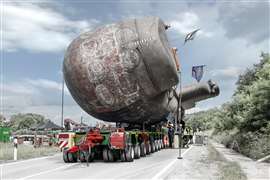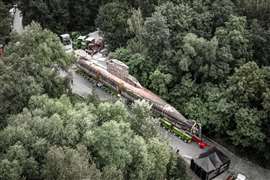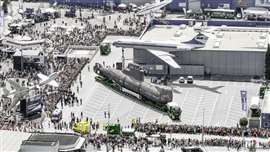Epic transport: Submarine transported across Germany
08 August 2024
Germany-headquartered Kübler haulage company used 30 TII Scheuerle InterCombi axle lines to transport a U17 submarine from the Speyer Technology Museum to its sister museum in Sinsheim, Germany.
As the structure was 90 metres long and 10 metres high, and the journey involved navigating narrow roads, low bridges, and high-voltage power lines, it was a highly complex operation.
 The world’s first rotation of a submarine on a modular platform trailer. (Photo: TII)
The world’s first rotation of a submarine on a modular platform trailer. (Photo: TII)
So the U17 could pass safely under the obstacles, it had to be repeatedly rotated by 70 degrees around its longitudinal axis.
As a result, the tower was positioned to one side within a few minutes and the height of the transport was reduced to the required clearance and safely navigate the hilly Kraichgau region.
Balancing act
The journey began on the Rhine and Neckar rivers, starting from Speyer and passing through Mannheim to Haßmersheim. Initially, the submarine was loaded onto a river pontoon, requiring a careful balancing act. The 66 meter long and 11.5 meter wide pontoon had to be constantly re-leveled to accommodate the changing load.
 The U17 waits for the onward journey across the water at the Speyer natural harbour. (Photo: TII)
The U17 waits for the onward journey across the water at the Speyer natural harbour. (Photo: TII)
The Scheuerle modular transporters moved the submarine forward while the Kübler crew ensured the pontoon and U17 remained balanced using ballasting and axle compensation. After a three hour process, the submarine was ready for river transport.
At Haßmersheim, the U17 was jacked up 1.4 meters using eight hydraulic cylinders, allowing the Scheuerle InterCombi axle lines to drive under the submarine for the final leg of its journey.
 The axle compensation of the Scheuerle InterCombi vehicles helped with ballasting. (Photo: TII)
The axle compensation of the Scheuerle InterCombi vehicles helped with ballasting. (Photo: TII)
This stage also required precise balancing due to the strong currents of the Neckar river. The modular transporter moved the submarine centimeter by centimeter back onto land.
Tilt and bend
The road transport presented further challenges, including passing under a cement conveyor belt near Neckarmühlbach. For this, the submarine had to be tilted hydraulically on a low-loader.
The route continued through tight bends and narrow streets, including a stretch on the A6 motorway where the convoy had to drive against traffic at 15 km/h, accompanied by police escorts and support vehicles.
 U17 navigates narrow passages and tight streets of multiple German towns. (Photo: TII)
U17 navigates narrow passages and tight streets of multiple German towns. (Photo: TII)
In Bad Rappenau, the submarine was rotated once again to avoid high-voltage lines, and further obstacles were negotiated with precise manoeuvring.
The journey’s final stages involved passing under overhead power lines near Ittlingen, navigating narrow streets in Sinsheim, and negotiating tight spaces between buildings. The transport culminated in a grand arrival at the Sinsheim Technology Museum, accompanied by music, crowds, and applause.
The entire operation was the result of five years of planning and the expertise of Kübler, supported by equipment from Tii Scheuerle.
The successful transport of the U17 submarine was not only a technical achievement but also a public spectacle that brought together communities along the route.
The submarine is now set to receive visitors at the Sinsheim Technology Museum from summer 2025.
 The submarine arrives at the Technikmuseum Sinsheim after a 4 week journey. (Photo: TII)
The submarine arrives at the Technikmuseum Sinsheim after a 4 week journey. (Photo: TII)
CONTÁCTESE CON EL EQUIPO





